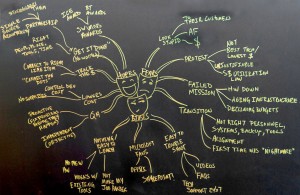The presentation process I teach is called U.S.E.—Understand, Summarize and Explain. Looking at the first step (Understand) there are three core elements: audience, need, and requirements (if applicable).
To be persuasive, our presentation must resonate with the audience. To do so, we want to empathize with them. If the audience waved a magic wand, what would be the perfect outcome (for them)? A presenter that understands their audience has an advantage. The more we know about our audience, the more persuasive our presentation.
Audience understanding and insight is usually captured in an ad hoc manner, if at all. Early in the process, the secret is to determine what matters most. To do this, I use a special mind map exercise I call the HFB Mind Map. This mind map helps me understand the audience’s
- Hopes: What do they want after the presentation? What is the best-case outcome?
- Fears: What keeps them up at night? What will make them worry?
- Biases: What types of solutions, messages, communication styles do they prefer? What do they dislike?
Use the following steps to create an HFP Mind Map:
- Step one: In the center of a piece of paper, large white board, or chalkboard, write hopes, fears, and biases.
- Step two: Ask yourself (or your team, if this is a group effort) to name specific hopes, fears, and biases. Use branches to connect each element to their respective sources.
- Step three: Dissect each of those hopes, fears, and biases. Continue to do so until you can no longer break down the elements into their key contributors. The intent is to uncover and define how the audience describes their hopes, fears, and biases. These three elements are key motivators to human change and choice.
The following is an example of a HFB Mind Map:
In my experience, you will jump from one component (hopes, fears, biases) to the next when making the HFB Mind Map. It is unlikely you will complete one of the three components without populating another.
In addition, the HFB Mind Map exercise can uncover key messages. For example, if you see a reoccurrence of a resonating idea (e.g., save money), it is likely to be a dominant motivator for the audience and should be woven into your presentation.
Using my HFB Mind Map approach speeds development and helps eliminate revisions because you (plus other contributors and your client, when applicable) empathize with the audience. You are more likely to share what the audience needs to understand to take the next step.



Recent Comments